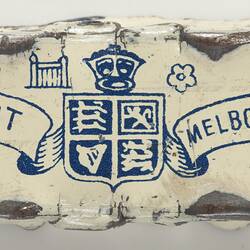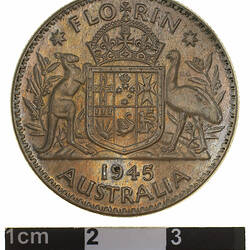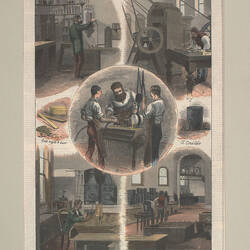Summary
Copper one Penny token, minted by Thomas Stokes of Melbourne. Issued by Thomas Stokes, Diesinker, Token Maker & Medallist, Melbourne, in 1862. Surcharged J. T. This token is one of the large number of anonymous tokens struck by Stokes late in 1862. Anonymous issues were manufactured employing two stock dies. Thomas Stokes migrated to Australia in search of gold in the 1850s, being unsuccessful he returned to his trade as a die-maker and button maker. In 1857 Stokes acquired a press from W.J. Taylor and began to mint large numbers of tradesmen's tokens. He also commenced the Australian Medallic Issues. In 1873 Stokes took a partner, Martin, and the business was re-named Stokes & Martin. In 1893 a disastrous fire damaged a large portion of the business, Martin had forgotten to renew the fire insurance policy, and the partnership was dissolved as a result. Stokes rebuilt the business as Stokes & Son. The business became a proprietary concern in 1911, re-named Stokes & Son Pty Ltd. In 1935 the business moved to Brunswick, and in 1962 Stokes became a public company, renamed Stokes (Australasia) Pty Ltd. Today the business is located in Ringwood.
Physical Description
A round copper token (34 mm diameter) without the name of an issuer or mint. The obverse (so called as all 'anonymous' issues by Stokes have a version of it) is the stock Vine: at centre within a line circle a piece of grape vine with nine large leaves and two bunches of grapes; around above, VICTORIA 1862, around below the Latin IN VINO VERITAS. The reverse is from a stock Wheat Sheaf die. This token has been surcharged J.T.
Obverse Description
At centre within a line circle in five lines, the first and last curved, T. STOKES / 100 / COLLINS ST. / EAST / MELBOURNE around, MILITARY ORNAMENT BUTTON & TOKEN MAKER :
Reverse Description
At centre a wheat sheaf tied with a cord 4.7 mm long, above, ADVANCE AUSTRALIA; below, 1862 border of 114 beads. (Stock reverse Andrews type 21 = Heyde Sheaf 1 = Sharples Sheaf 1) surcharged J.T.
Edge Description
Plain
More Information
-
Collection Names
-
Collecting Areas
-
Acquisition Information
Transfer from National Gallery of Victoria (NGV), 15 Mar 1976
-
Date Issued
1862 AD
-
Issued By
Melbourne, Greater Melbourne, Victoria, Australia, 1862
Possibly stamped by J.T.Thomas of Geelong, who issued other token patterns around this period. -
Mint
Stokes (Mint), 100 Collins Street East, Melbourne, Greater Melbourne, Victoria, Australia, 1862
-
Previous Collection
-
Inscriptions
Obverse: T. STOKES 100 COLLINS ST EAST MELBOURNE MILITARY ORNAMENT BUTTON & TOKEN MAKER : Reverse: ADVANCE AUSTRALIA 1862 surcharged J.T.
-
Denomination
-
Series
-
Material
Copper
-
Axis
12
-
Classification
-
Category
-
Discipline
-
Type of item
-
Dimensions
34 mm (Outside Diameter), 12.68 g (Weight)
-
Shape
Round
-
References
Stokes products which do not carry the name of an issuer but only reference to Stokes itself, are divided into four series: Series 1: has the wording T. STOKES or THOMAS STOKES MAKER MELBOURNE around the address in three lines 100 COLLINS ST. EAST plus one die where the central wording is ONE PENNY TOKEN in two lines. Series 2: has a description of the types of product, eg. BUTTON CHECK & TOKEN MAKER, around the name and address of the company, T. STOKES 100 COLLINS ST. EAST MELBOURNE. All but one die in this series has a line circle between the name and address and the products. Series 3: employs Stokes stock reverse dies for both sides of the token. In all cases one side has a Vine type, this is therefore called the obverse. Series 4: has an obverse legend in eight lines with the first, T. STOKES, and last, MELBOURNE, curved. This token belongs to Series 2 with Obverse L. Within this series there were eight obverse dies all employed with stock 1862 reverse dies. The different obverse forms are generally easy to identify. All have the legend T. STOKES / 100 / COLLINS ST. / EAST / MELBOURNE. With the exception of dies D and C (which is not known from an 1862 strike), all have a line circle around this legend - obverse D has MELBOURNE at the rim. The remainder have variations in the exact form of the surrounding legend: Obverse D: BUTTON CHECK & TOKEN MAKER Obverse E: CHECK & TOKEN MAKER (NU 35746 for the original die) Obverse F: LETTER CUTTER BUTTON CHECK & TOKEN MAKER : Obverse G: LETTER CUTTER - BUTTON CHECK & TOKEN MAKER : (NU 35742 for the original die)Obverse H: LETTER CUTTER SEAL ENGRAVER TOKEN MAKER . (NU 35733 for the original die) Obverse I: LETTER CUTTER . SEAL ENGRAVER . TOKEN MAKER Obverse J: LETTER CUTTER . SEAL ENGRAVER . TOKEN MAKER . Obverse L: MILITARY ORNAMENT BUTTON & TOKEN MAKER : (NU 35740 for the original die) Note: Obverse E has only been recorded on Twentieth century late work - concoctions. The die itself is in the museum collection NU 35746
[Book] Andrews, Arthur. 1921. Australasian Tokens and Coins., No.541
[Book] Heyde, Gilbert C. & Skinner, Dion H. 1967. Unofficial Coins of Colonial Australia and New Zealand., No.234/21
[Article] Sharples, John P. 1993. A Catalogue of the Trade Tokens of Victoria 1848 to 1862. Journal of the Numismatic Association of Australia. vol.7: p.1-77., No.V.152
-
Keywords









